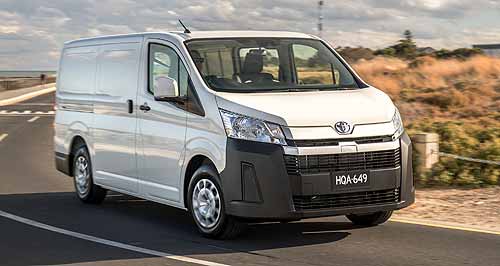News - Market Insight - Market Insight 2021Market Insight: Vans strengthen sales despite COVIDStrong signs: Both the small and medium van segments have shot out of the gates in 2021. Cart horses of the economy a reflection of local business strength and wealth24 May 2021 By NEIL DOWLING THE omnipresent reflection of work vehicles is no better seen than in the plethora of utes and vans on the city streets and regional highways.
They mirror the economy – the more utes and vans on the road, the more business is being served and the more money there is flowing through small and medium businesses.
In particular, vans showcase the amount of work around because they're rarely purchased for any other reason than to move goods. Utes, as is obvious, have large roles in leisure and non-work markets.
The flow-on effect trickles pretty much everywhere, from the company making the vans to the distributors and dealers and then the businesses that buy them.
In year-to-date April new-vehicle data, the light-commercial vehicle segment in which utes and vans sit, has increased by 43 per cent over the same period in 2020 to become the fastest-growing segment and posting positives that far outweigh the vehicle average growth for the period of 30.7 per cent.
The Australian market defines the vans as sub-2.5-tonne GVM and 2.5-3.5-tonne GVM segments.
Businesses wanting a van in the smallest category currently have a choice of four models, dominated by the Volkswagen Caddy (66.3 per cent market share) and Renault Kangoo with 24 per cent.
This category is designed specifically for the city and suburbs with the accent on nimble roadholding, tight turning circle and maximum cargo space.
Volkswagen’s Caddy, for example, has 3.2 cubic metres of load area and a 725kg payload, while its long wheelbase version has 4.2m³ and can take up to 842kg of load.
Peugeot’s Partner is back in the market after a five-year break and replaces its sibling, the Citroen Berlingo, that has been retired under a realignment of PSA’s Peugeot and Citroen models in Australia.
It has a 1000kg payload and 3.9m³ of storage space, while Renault’s Kangoo has 540-795kg of payload and 3.0-4.0m³ of cargo room, depending on the wheelbase chosen.
This small end of the van segment has also seen the demise of the Indonesian-built Suzuki APV that went because of failure to meet new safety regulations, specifically a lack of stability control.
Despite it going in 2017 after almost 20 years virtually unchanged, there’s still hundreds – possibly thousands – on Australian roads that shows that the package worked extremely well in satisfying SME needs for a city delivery van.
Thanks to its brick-like silhouette, it had a cargo volume of 3.4m³ and a 600kg payload, with its almost bonnetless profile giving it more cargo floor length than its rivals.
The bigger 2.5-3.5-tonne segment has a lot more interest with sales this year to the end of April at 8589 units, substantially larger than the sub-2.5t sector at 504 sales.
Toyota’s HiAce is the king of this segment, picking it back up in 2020 after playing second fiddle to Hyundai’s iLoad in 2019 with the catalyst being the all-new model boasting more cargo space and improved occupant safety, including the placement of the occupants behind the front axle line.
Toyota leads this segment with a 38.3 per cent share in calendar 2020 but a year earlier had 22.2 per cent against the Hyundai at 27.9 per cent. Hyundai also beat the HiAce in 2017 when it outsold it and captured 34 per cent of the segment.
One new model was all it took for Toyota to regain the crown.
Ford’s upgraded Transit range has been a strong player, coming from a market share in 2016 of 6.0 per cent before dropping to 4.0 per cent in 2017. It now has a 13.1 per cent stake and lots of satisfied owners.
Another riser is the Mercedes-Benz Vito range that had a 5.7 per cent share in 2016 and now has 11.4 per cent, while Volkswagen has slipped to 3.1 per cent with its Transporter, down from 9.9 per cent in 2016.
The over-2.5-tonne range has sold 1991 units in April and amassed 8589 new owners in the four months of the year.
In perspective, this is almost twice the number in the same period in 2020 and over five times the number sold in 2016.
The smaller vans haven’t escaped the attention. It had its best year-to-date result in 2019 with 763 sales, which was eroded in 2020 with 571 units and again this year with 504 sales. But this year’s result to date is double that of the 248 sales in 2017.
Some of this increase is connected to the instant tax write-off of 2020 and incoming for 2021, although that incentive would play a very small part in the rise of van sales.
More is attributed to fleet buying schedules and even more to the high used-vehicle prices of late 2020, early 2021 that enticed owners into new vans.  Read more |
Click to shareMarket Insight articlesResearch Market Insight Motor industry news |



















Facebook Twitter Instagram